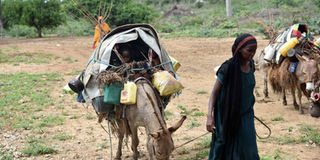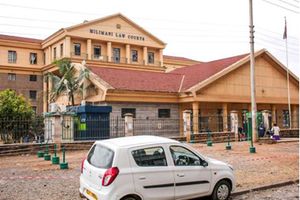Premium
A tale of resilience in face of disease, harsh weather

An Orma pastoralist with her children on the Garsen-Hola Road. PHOTO | EVANS HABIL | NATION MEDIA GROUP
Under the scorching sun on the Garsen-Hola road walks a woman leading a donkey by a rope. On top of the donkey is what looks like a hut made from animal hide and plastic pieces.
On closer look, we realise there’s a child inside the hutlike shade, no older than two years, and a well wrapped baby lying beside him.
A weak, emaciated Mariam Ali had been on the road for six days, after walking a distance of 130km from Marafa in Kilifi County to Garsen in Tana River County. She still has another 128km to her home in Haroresa, Tana River.
She’s a new mother and the heavy rain has only made the journey harder.
When an expectant Mariam started the journey from Haroresa to Marafa, she knew her due date was close, but there was no time for preparations as a drought had ravaged their village and they were at risk of starvation and losing their livestock.
As fate would have it, she gave birth by the roadside several days into the journey.
WENT INTO LABOUR
Mariam is pastoralist and together with her family and neighbours, they were forced to move to Marafa five months ago during Ramadhan to look for pasture for their livestock.
The harrowing journey as a new mother will remain etched in her mind for years to come. By the end of the pasture cycle, she covered at least 500km.
When HealthyNation meets Mariam on the Garsen-Hola road, she’s exhausted from the journey. She only understands her native Orma dialect and through a translator says: “It’s been hard especially because of the rain. The donkey is sometimes overwhelmed by the commodities it is carrying.”
Without food, water and medical attention, they have been forced to make numerous stopovers. The situation would have been harder for Mariam had it not been for the other women. When she went into labour, they stopped and helped her deliver the baby. “The baby, however, fell ill almost immediately,” says the translator, who does not want to give her name.
Sometimes the herders are seen taking rain water collected in puddles on the road or begging for some from travellers. “It’s only God who helps them in the journey. If someone is sick and gets worse, they ride on a boda boda to go and buy painkillers from the nearest shopping centre,” says Halakhe Wato, a National Drought Management Authority officer.
When it rained, Mariam and other women walked sandwiched by men and more herds of goats and cattle.
In the past several days, she has been heavily rained on and she and her five-month-old baby are now sick.
Since he was born, Mariam’s baby has not received any of the crucial vaccines and has not been given proper medical care during and after birth. The mother had hoped to arrive in Haroresa in good time to go to a hospital for vaccination. However, it will be too late for the baby to receive some of the vaccines. For example, vaccination against hepatitis is usually given at birth.
Polio vaccine is given for the first time at birth, six weeks, 10 weeks and 14 weeks within the first year of life. Lack of vaccination may result in permanent paralysis.
For measles and rubella, if the baby is not vaccinated at nine months, he risks getting the disease, which can cause brain swelling, brain damage and or death. “We are yet to receive help since we are still on the road,” says her translator, a young woman, who tells HealthyNation she has never been to school and her little Kiswahili is self-taught.
UNPREDICTABLE WEATHER
This is the story of pastoralist women of Tana River and like many pastoralist communities, the erratic weather patterns mean displacement resulting in lack of essential medical and other services. Kenya has more than 13 million pastoralists.
In July and September this year, drought and resilience officers in the Tana River came across migrating pastoralists with about 20 women who had delivered on the road during the perilous journey, says Wato.
According to the Kenya Demographic and Health Survey 2014, the county’s infant mortality rate is 66 in every 1,000 children.
While the national maternal mortality rate is 510 for every 100,000 live births, Tana River’s stands at 180 per 100,000 live births, shows the survey.
Normally, the pastoralists cover the one-way distance in seven to 10 days, but on some occasions, like when they get pasture en route or in case of an emergency, they take between two and three weeks.
According to Wato, pastoralists used to know exactly when to move in and out of the Tana Delta and other places in search of pasture, but not any more due to unpredictable weather. As a result, they are caught up in the chaos brought about by climate change. “The seasons have become more unpredictable and their (pastoralists) method of predicting weather is compromised,” says Wato.
Data shows that Tana River receives annual relief rainfall of between 400mm and 750mm with a mean annual temperature range of between 30 and 33 degrees Celsius. This year’s October-November-December rainfall came earlier than usual and they were caught off-guard at the Delta and in other regions they had moved to.
Immediately they got wind that it had rained in Hola, they started their journey back home with the expectation that the rain and the pastures will last. “At the beginning of October, they were supposed to be in the Delta. But, they now have to move out fast. Traditionally, they would have moved towards the end of the month,” he says.
Unfortunately, those left behind (in the delta other areas) thinking that the rain would not last, got caught up in the wilderness, and the effect was catastrophic, their livestock died. This is because too much rainwater causes hypothermia and animal diseases such as foot rot.
During the 2017-2018 drought, Bocha Mgalla, a resident, had at least 400 cattle. Currently, he only has 50 cattle.
Land in the county is mostly non-arable, making pastoralism the Orma’s mainstay, and because of this, the erratic weather pattern has them worried.
BROKE BANKS
Tana River is one of the 23 counties in arid and semi-arid lands (Asals), which constitute over 70 per cent of Kenya’s land mass.
Other counties include Baringo, Garissa, Isiolo, Mandera, Marsabit, Samburu, Turkana, Wajir, Embu, Kajiado, Kilifi, Kitui, Kwale, Laikipia, Lamu, Makueni, Meru, Narok, Nyeri, Taita-Taveta, Tharaka Nithi and West Pokot. “Migration is one of the ways of coping with this. But, the pattern of movement has changed,” elaborates Wato.
Initially, women in Tana River would not move far. The men would go with part of the herd and leave some animals behind for milking. With this, the women had food and would sell some of the milk to buy other basic items.
But, they have joined the mass exodus and now travel hundreds of kilometres because all the cattle is driven south as the drought is more severe. “When you see so many of them moving, it means they did not leave any livestock behind,” he said.
As a result, children miss vaccines and medical care as well as lose out on schooling. Mothers also lack the medical attention they need during and after birth.
Tana River County covers a total surface area of 38,437 square kilometres and accounts for 6.6 per cent of Kenya’s total surface area. Officials have attributed its vast size to the poor reach of medical and other essential services.
Mariam is among more than 1,000 women of Tana Delta who have lived in internally displaced people (IDP) camps in Minjila, Garsen, for over one year.
The ongoing heavy rainfall added to their woes, having been displaced by floods from Galili in March 2018 when River Tana broke its banks.
The rain sickens them (quite literally), just like drought does.
They are among 3,000 residents who have been in three camps of Mwangaza, Dar-es-Salaam and Ramadha, on the Garsen-Hola road.
Heavy rainfall in the past several weeks has resulted in flooding in Tana River including in the camps.
TEEN PREGNANCY
Nineteen-year-old Fardosa Mustafa, a mother of a five-month-old baby, has stayed in the makeshift village of Mwangaza for the past one and half years and besides fearing the floods, the cold weather has made her child sick. “I delivered in the manyatta, but the rain has not spared us. My baby is sick and I don’t have any money to take her to the hospital,” she tells HealthyNation.
The baby has had flu since she was born and suffers from frequent chest problems and diarrhoea, says Fardosa, a Form Four leaver. “By now she should have started crawling, but she is yet to because she is always sick,” she adds.
Her sister’s child is suffering from pneumonia. The sister, Rukia Mustafa, is also suffering from the disease.
They are not the only ones. Hadija Noor, a mother of 10, contracted pneumonia and dreads sleeping on the cold-mud floor.
The nearest public hospital is more than five kilometres away at Idsowe. “Babies are not getting vaccinated, we have not received any medical help for our sick camp members,” says the village headman Osman Mahmud.
They left their livestock in the flooded villages along River Tana during the 2018 March-April-May rains. “We were told to stay here because it is safer, and were promised houses by the government. We wonder what happened,” says the headman.
The situation is not any different during the dry, hot weather as they cannot stay inside the houses during the day because the black polythene sheets on their roofs absorb heat, and so they are contended sitting outside until it starts raining, again.
Speaking to HealthyNation, Tana River Health minister Mwanajuma Hiribae said although maternal and child health indicators had improved in the county, reaching migrating pastoralist groups was still hard. “We plan to work with community health volunteers to track the migrating communities and gather intelligence on the health issues affecting them,” she said.
Ms Hiribae said the number of skilled deliveries in the county was still very low especially because of cultural barriers. Teenage pregnancies remained high. “However, a geographic information system laboratory is in place and it will be able to help in tackling such health challenges especially in the most affected areas of Tana River County,” she said.
A geographic information system collects data on different issues and through this, authorities can monitor what is happening on the ground including migration.


